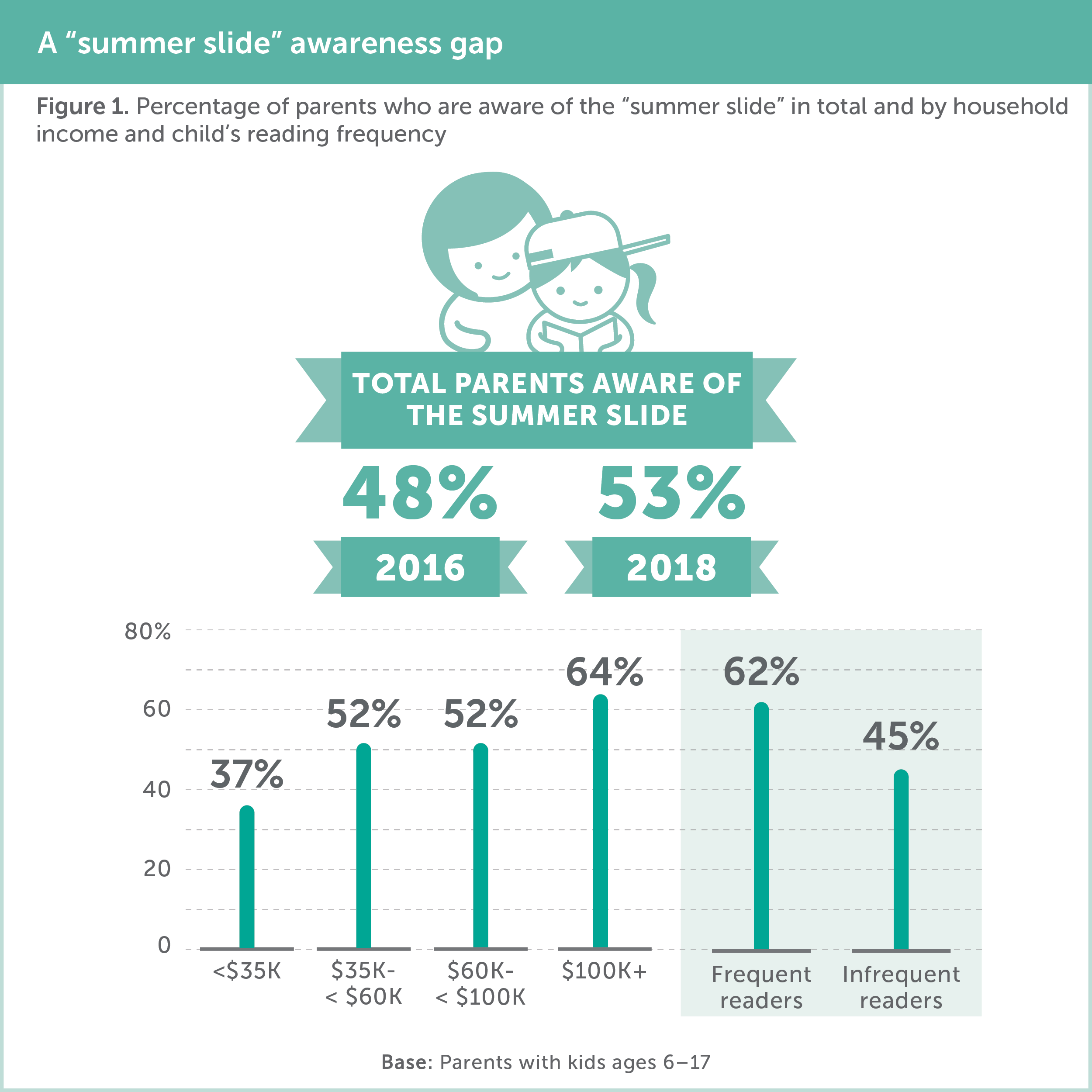
A SUMMER READING AWARENESS GAP FOR PARENTS
At first glance, parents seem aware of the importance of summer reading, as 94% agree reading over the summer can help their child during the school year. And yet, nearly half of parents with school-age children are unaware of the “summer slide” (47%), the loss of academic skills that occurs when school is not in session and which is attributed largely to the lack of reading. This is of critical importance as the effects of the summer slide are cumulative. Researchers estimate that by the time a struggling reader reaches middle school, summer reading loss has accumulated to a two-year lag in reading achievement1. A case can be made that we can begin to address this contributing factor to the reading achievement gap by addressing an information gap. The Kids & Family Reading Report reveals that when parents are aware of the summer slide, both children and parents are more engaged in summer reading.
It’s encouraging that awareness of the summer slide has increased five points since 2016 (48% vs. 53%). However, there are significant disparities around awareness among certain subsets. Similar to other reading habit trends, parents of frequent readers (kids who read books for fun 5–7 days a week) are far more likely to have the summer slide on their radar than are parents of infrequent readers (kids who read for fun less than one day a week). Lower-income families, as was the case in 2016, remain less likely to be aware (See figure 1). This is of notable concern as the summer slide is a primary contributor to the reading achievement gap between lower- and higher-income students2. What's more, out-of-school experiences, particularly unequal summer learning during early formative years, have been shown to account for the majority of achievement differences among socio-economic statuses by the time students reach ninth grade3. All heightening a need for greater communication around summer reading for lower-income families.
Click Here for High Resolution Image
1 Alexander, K. L., Entwisle, D. R., & Olson, L. S. (2007). Lasting consequences of the summer learning gap. American Sociological Review, 72(2), 167–180.; Cooper, H., Charlton, K., Valentine, J. C., & Muhlenbruck, L. (2000). Making the Most of Summer School: A Meta-Analytic and Narrative Review. Society for Research in Child Development, vol. 65, no. 1. Allington, R. L., & McGill-Franzen, A. M. (2003). The impact of summer setback on the reading achievement gap. Phi Delta Kappan, 85(1), 68–75.
2National Summer Learning Association, (2017). State of summer learning: 2017 state policy snapshot.
3Alexander, K. L., Entwisle, D. R., & Olson, L. S. (2007). Lasting consequences of the summer learning gap. American Sociological Review, 72(2), 167–180.
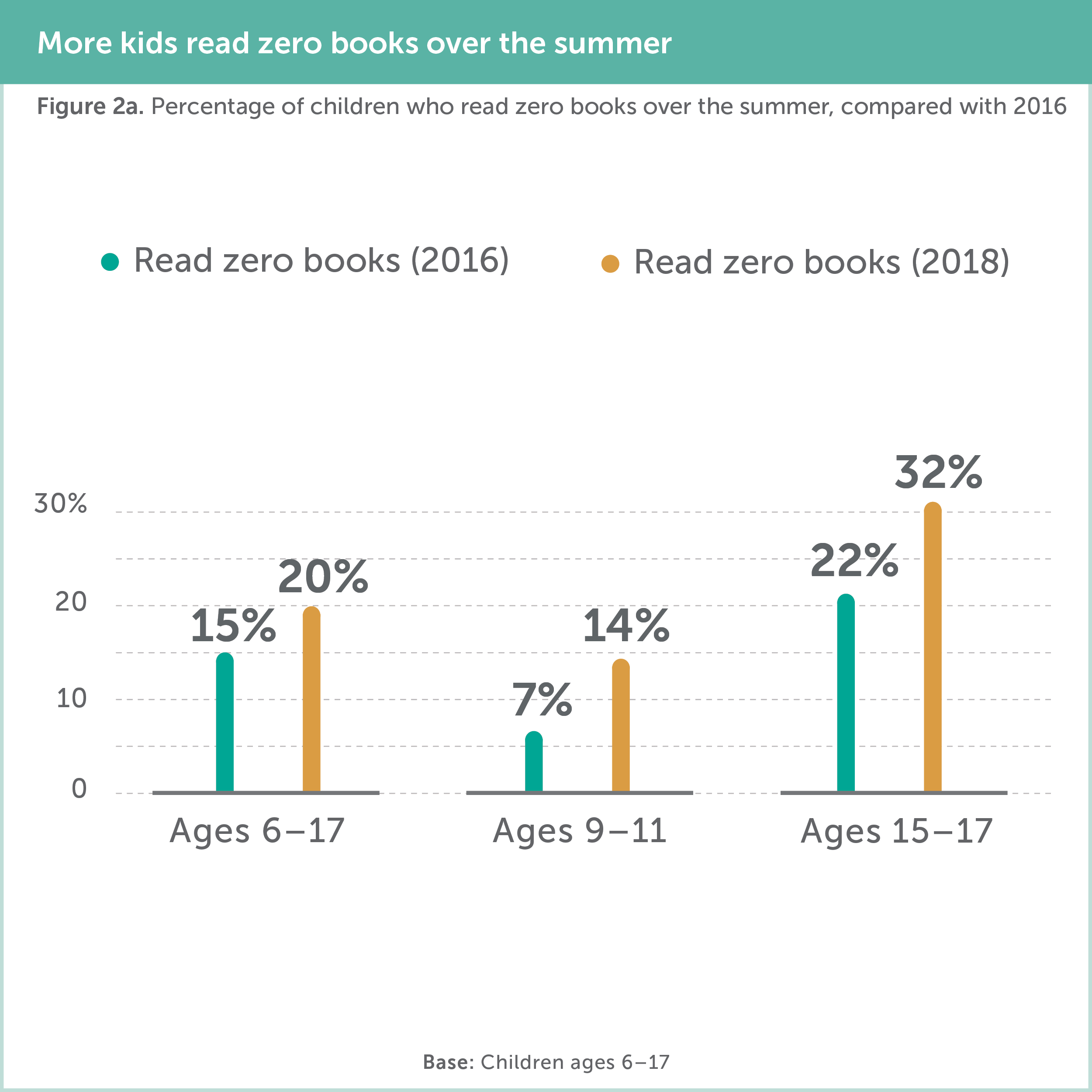
SUMMER READING TRENDS TO WATCH AMONG KIDS
Most kids know that summer reading provides benefits that extend well past the summer months. Seventy-seven percent agree that reading over the summer will help them during the school year and on average, kids read nine books in the summer of 2018.
Where the significant concern lies, is in the number of kids who do not read any books at all over their summer breaks (See figure 2a). Thirty-two percent of kids ages 15–17 said the number of books they read over the summer was zero, up sharply since 2016 (22%). The trend line among kids ages 9–11 also needs to be watched: the percentage who read zero books over the summer has doubled since 2016 (7% to 14%). Notably, if a parent is aware of the summer slide, their child is less likely to read zero books over the summer (16% vs. 25%).
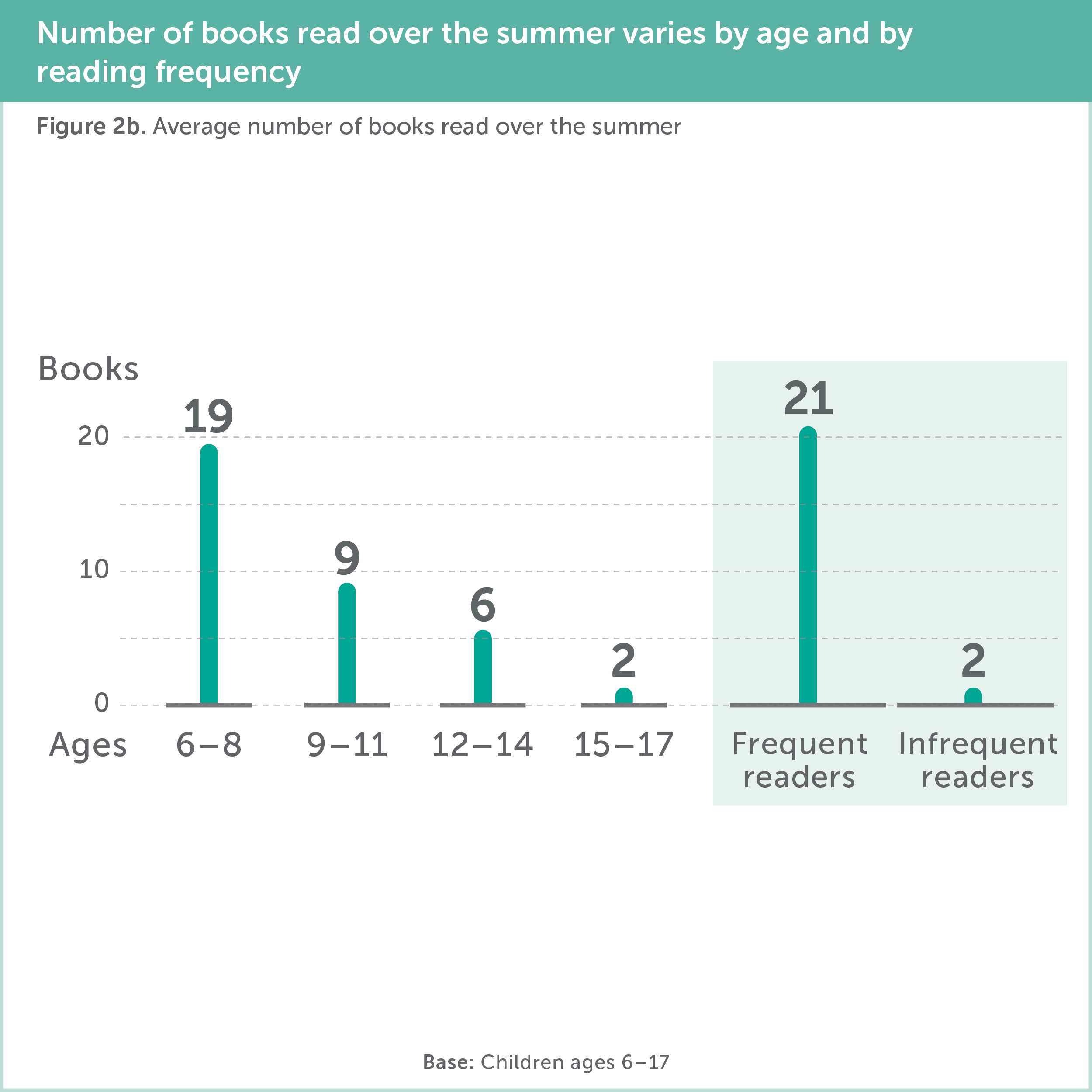
As with many trends found in the Kids & Family Reading Report, the number of books read over the summer varies widely by age (See figure 2b): kids ages 6–8 read an average of 19 books; that number drops to nine among 9–11s, six among 12–14s and two among 15–17s. Some of the decline in the number of books read can be attributed to the length of books kids are reading increasing as children grow older. Nonetheless, the trend line is troubling.
Frequent readers are by far the most active readers over the summer months, reading an average of 21 books vs. only two among infrequent readers. This difference is largely due to the high percentage of infrequent readers who do not read any books at all during the summer: 46% of infrequent readers ages 6–11 and 52% ages 12–17 read zero books over the summer.
And knowing that frequent readers are far more likely than infrequent readers to have books in their homes (139 vs. 74 books on average), access during the summer is undoubtedly a factor.

BOOK ACCESS DIMINISHES DURING THE SUMMER
Kids identify schools and public libraries as the main sources for most of the books they read for fun. With 53% of kids getting access to books through school and 50% getting them from the public library, it is no surprise that the vast majority of parents believe that every child needs to have a school library (95%) and every community needs to have a public library (95%) (See figure 3a/b). Even a new mother shared her appreciation for libraries, saying, “I want to borrow books from the library and attend story hour and learning events when she is older.” Yet in most cases, school-related points of access are the least available over the summer. Research on book deserts—areas with a stark lack of access to print materials—showed in the studied urban areas that the summer months drastically limit book access in high-poverty neighborhoods4.
The Teacher & Principal School Report5, a companion study to the Kids & Family Reading Report, found that the vast majority (96%) of teachers, principals and school librarians say that providing year-round access to books at home is important to enhancing student achievement. An example of how taking an active role in this can lead to results was displayed recently in two district-wide initiatives that provided books and family literacy nights to K–6 students and families over the summer. Research conducted by Scholastic Research & Validation revealed that this approach was associated with students maintaining or increasing literacy skills while school was out. Specifically, 78% of students in one district maintained or increased their reading levels from spring to fall; in the second district fewer struggling readers (21% vs. 30%) and fewer advanced readers (34% vs. 43%) experienced summer reading loss when they had access to these resources before the start of summer6.
Click Here for High Resolution Image
4 Neuman, S. B., & Moland, N. (2019). Book Deserts: The Consequences of Income Segregation on Children’s Access to Print. Urban Education, 54(1), 126–147
5scholastic.com/teacherprincipalreport
6Scholastic Research & Validation. (2018). Empowering students and families to address summer reading loss in Greenville, SC and Stoughton, MA 2017. New York, NY: Scholastic Inc.
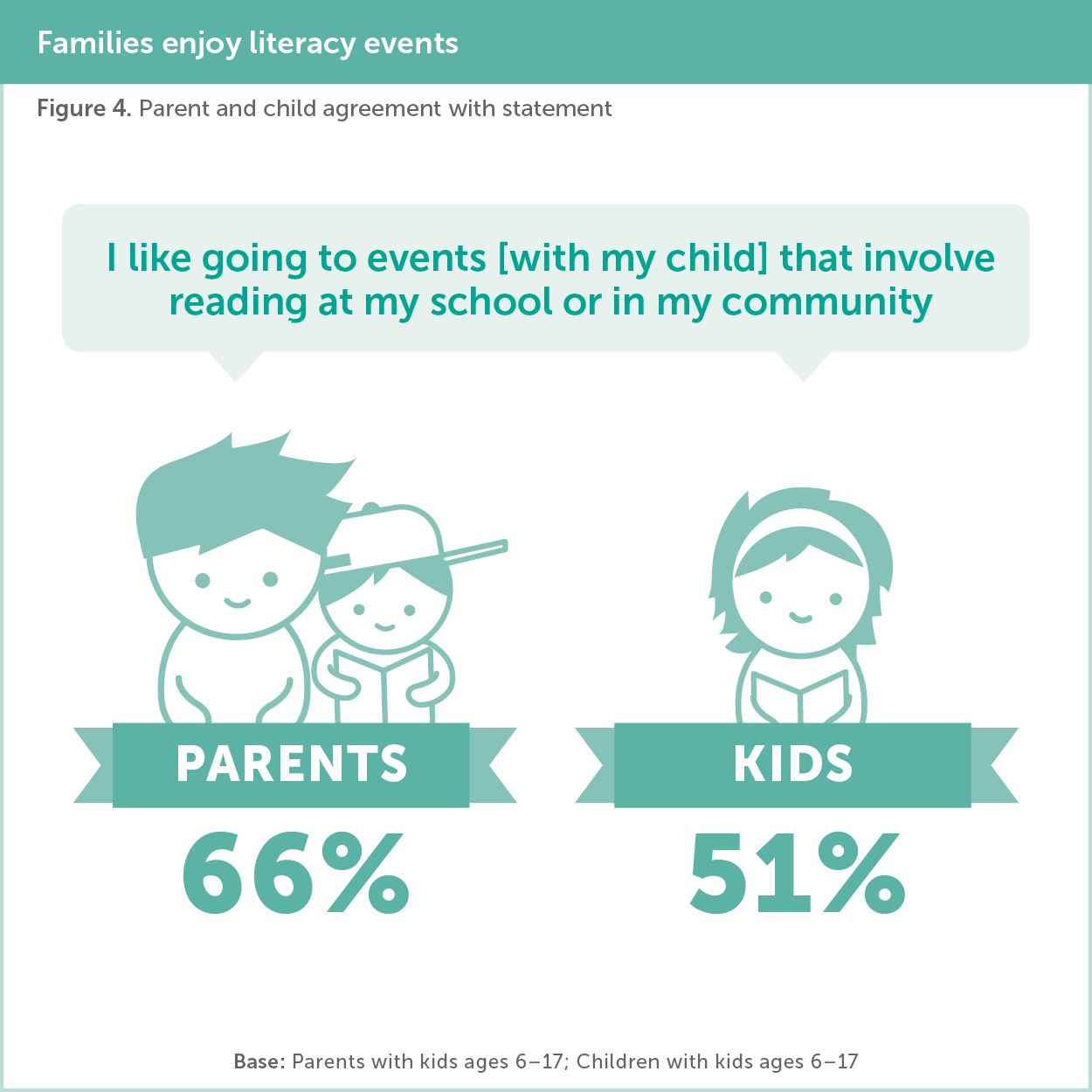
SCHOOLS AND COMMUNITIES CAN BE A BRIDGE FOR SUMMER READING
Bringing schools, communities and families together is a powerful combination to support summer reading. First and foremost, schools are the top source of information on the summer slide, with 59% of parents who are aware of the summer slide citing their child’s teacher, or school in general, as providing information on the topic. News media is the number two source, coming in at a distant 24%.
In the Scholastic Research & Validation research referenced earlier7, providing K–6 students and their families with increased access to books and learning opportunities over the summer displayed positive impacts among families. The research highlighted that in the two participating districts, 95% and 85% of families agreed that the Family Reading Night was valuable in learning how to support their children’s reading. Additional supportive findings include: 60% of families agree they learned ways to talk to their children about books and 94% of families agree the Family Reading Night was a great way to connect families and schools.
Yet only some families are benefiting from school and community literacy events. Data from the Kids & Family Reading Report reveal about four in 10 (39%) parents say their school or community has hosted a reading event in the past few years and two in three of these parents say the event was attended by their child (64%) or themselves (37%). Many of these events likely take place during the school year, diminishing parents’ access to support around literacy over the summer. Since half of kids and two-thirds of parents agree that they like going to events involving reading (See figure 4), communities have an opportunity to come together to help foster summer reading. Similar to the trends observed in reading frequency, enjoyment and importance in the Kids & Family Reading Report: Finding Their Story, enjoyment of these events diminishes as kids age, from a high of 72% among children ages 6–8 to a low of 29% among children ages 15–17. Parent interest, however, remains relatively high across children’s ages at 75% among parents of kids ages 6–8 and about six in 10 among parents of both 12–14 and 15–17 year-olds.
"I enjoy losing myself in a good book. I love visiting faraway lands and meeting characters."
—14-year-old girl
Click Here for High Resolution Image
7 Scholastic Research & Validation. (2018). Empowering students and families to address summer reading loss in Greenville, SC and Stoughton, MA 2017. New York, NY: Scholastic Inc.
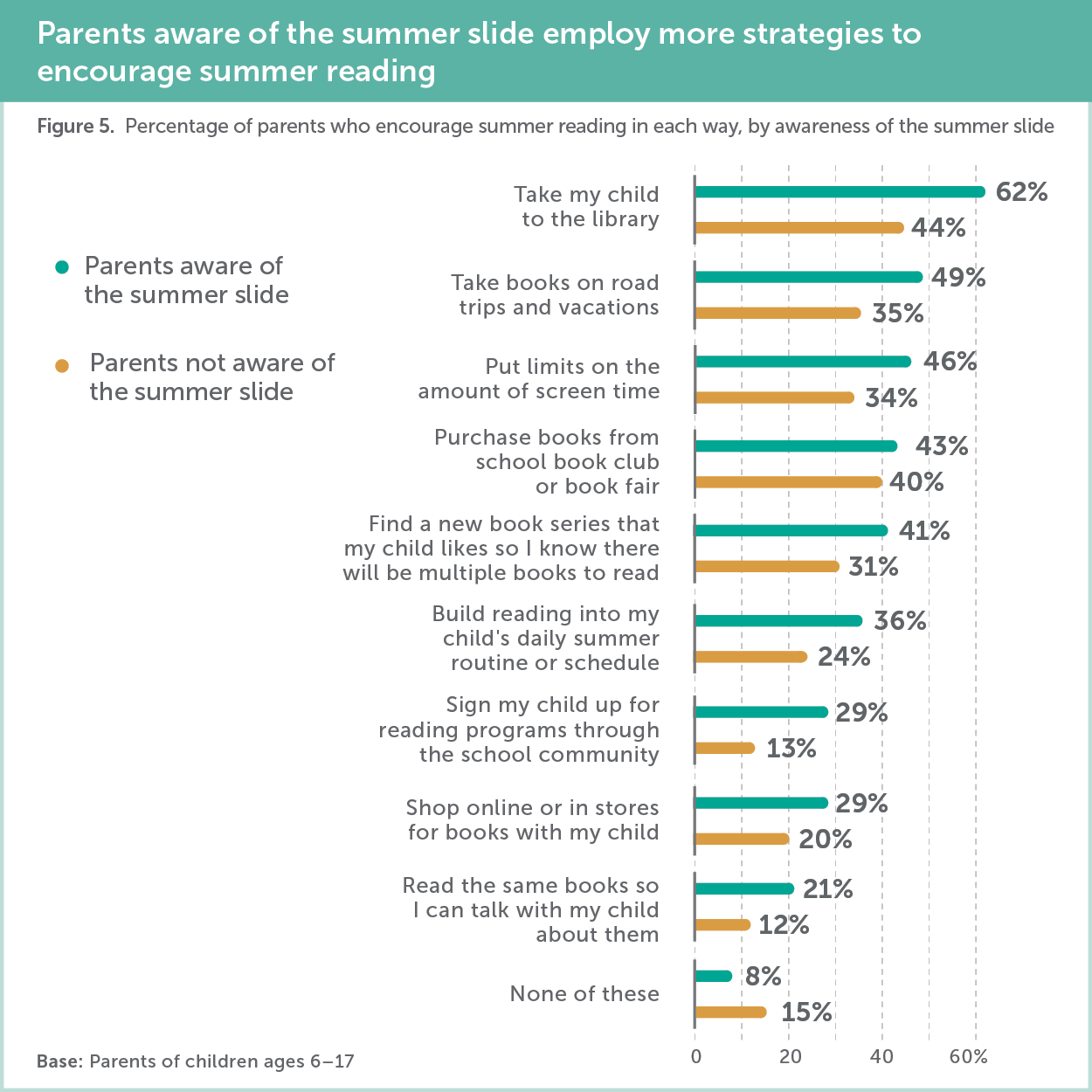
AT HOME, PARENTS FOCUS ON BOOK ACCESS TO SUPPORT SUMMER READING
To better understand reading behavior among kids and their parents when school is out, the Kids & Family Reading Report probed the different strategies parents use to encourage summer reading at home. Notably, the top three all centered on creating book access and choice for the child: taking trips to public libraries ranked first (54%), followed by ordering from school book clubs or book fairs (42%) and taking books on road trips or vacations (42%). Parents also reported putting limits on screen time (40%), finding new book series (36%) and purposefully making reading part of the summertime daily routine (30%), with fairly significant variation across ages of children. As one 14-year-old boy noted, “Reading for fun is a habit now. I enjoy reading and learning about different things. This summer I read less, because of football, but my mom made sure we went to the library before practice.”
Parents who are aware of the summer slide are more likely to engage in nearly all activities to encourage their children to read while school is out (See figure 5). And a peer-reviewed study—published by the American Library Association in 2017 and centered on the effect of summer program participation among fourth grade students in North Carolina—found that if parents understand the summer slide, they prioritize transportation to the library to facilitate summer reading8.
Click Here for High Resolution Image
8 Becnel, K., Moeller, R. A., & Matzen, N. J. (2017). “Somebody Signed Me Up”: North Carolina Fourth-Graders’ Perceptions of Summer Reading Programs. Children & Libraries: The Journal of the Association for Library Service to Children, 15(3), 3–8.
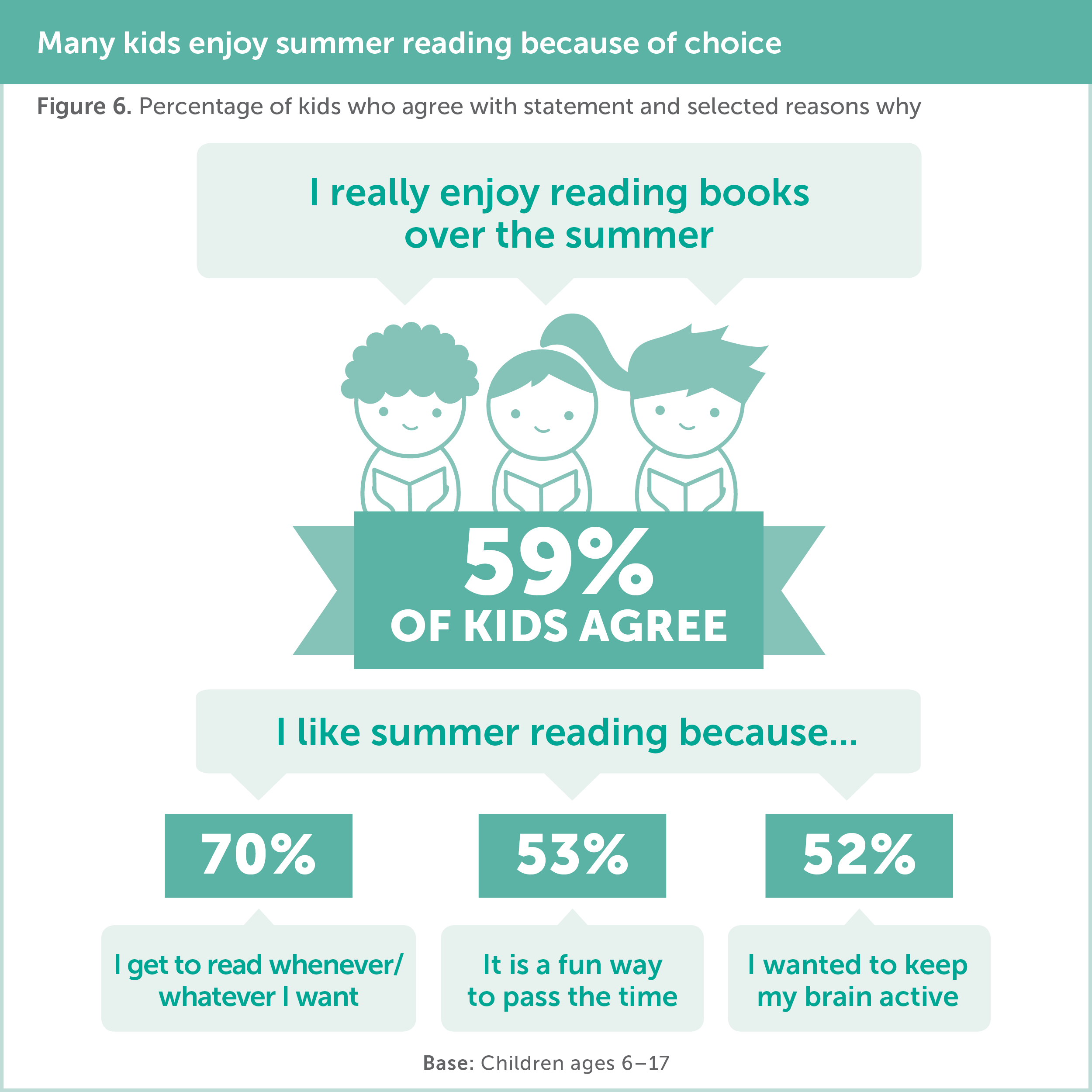
THE POWER OF CHOICE DRIVES KIDS’ ENJOYMENT OF SUMMER READING
Counter to conventional thought, the view that summer reading is a chore is not shared by a majority of kids today. More than half (59%) of all kids ages 6–17 say “I really enjoy reading books over the summer” (See figure 6). Perhaps unsurprisingly, given other patterns observed throughout the findings of the Kids & Family Reading Report, younger children and frequent readers are more likely than teens and infrequent readers to enjoy reading books over the summer. Additionally, kids whose parents are aware of the summer slide also feel more positively about summer reading.
When given the opportunity, kids believe participating in a summer reading program prompts them to read more. Twenty-two percent of kids told us that they participated in a summer reading program or contest and 65% said their participation resulted in reading more than they otherwise would have. Yet this opportunity was not afforded to all children: half said they didn’t know of any summer reading program in which they could have participated.
Regardless of access to summer reading programs, frequency of reading books for fun, or whether a child is entering their early elementary years or is a rising senior in high school, the top reasons kids enjoy summer reading remain the same: it’s about the power to choose their books and read whatever and whenever they want (70%), to have an enjoyable way to pass the time (53%) and, in a nod to the savviness of kids, they want to keep their brains active (52%), and they know reading books can deliver on this.



